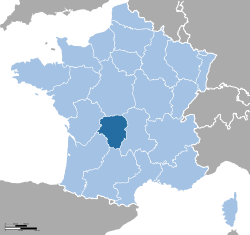Limousin (region)
| Limousin | |||
|---|---|---|---|
| — Region of France — | |||
|
|||
 |
|||
| Country | France | ||
| Prefecture | Limoges | ||
| Departments |
3
|
||
| Government | |||
| - President | Jean-Paul Denanot (PS) | ||
| Area | |||
| - Total | 16,942 km2 (6,541.3 sq mi) | ||
| Population (2007-01-01) | |||
| - Total | 727,000 | ||
| - Density | 42.9/km2 (111.1/sq mi) | ||
| Time zone | CET (UTC+1) | ||
| - Summer (DST) | CEST (UTC+2) | ||
| ISO 3166 code | FR-L | ||
| NUTS Region | FR6 | ||
| Website | cr-limousin.fr | ||
Limousin (French pronunciation: [limuzɛ̃]; Occitan: Lemosin) is one of the 26 regions of France. It is composed of three départements: Corrèze, Creuse and the Haute-Vienne.
Contents |
Formation
The modern region of Limousin is essentially composed of two historical French provinces:
- Limousin: the Corrèze department in its entirety and the central and southeastern part of Haute-Vienne. The old province of Limousin is entirely contained inside the modern Limousin region.
- Marche: most of the Creuse department and the north of the Haute-Vienne. The old province of Marche is almost entirely contained inside the current Limousin region, with only a small part of Marche being now in the Centre region.
Beside these two main provinces, Limousin is also composed of small parts of other former provinces:
- Angoumois: extreme south-west of Haute-Vienne
- Poitou: extreme west of Haute-Vienne
- Auvergne: extreme east of Creuse
- Berry: extreme north of Creuse
Today the province of Limousin is the most populous part of the Limousin region. Limoges, the historical capital and largest city of the province of Limousin is the capital of the Limousin administrative region.
Population
With a slowly rising population of just under 750,000, Limousin is the second least populous French region in Metropolitan France after Corsica. There are fewer inhabitants in Limousin than in the city of Marseille.
The population of Limousin is aging and, until 1999, it was declining. The Creuse department has the oldest population of any in France. Between 1999 and 2004 the population of Limousin increased slightly, reversing a decline for the first time in decades.[1]
Major communities
- Brive-la-Gaillarde
- Guéret
- Limoges
- Saint-Junien
- Tulle
- Ussel
- Saint-Yrieix-la-Perche
Economy
Limousin is an essentially rural region. Famed for some of the best beef farming in the world, herds of Limousin cattle—a distinctive chestnut red—are a common sight in the region. In addition to cattle, the region is also a major timber producing area.
Due to its rural locality it is also famed for its French Oak orchards, so prized for its distinct characters and flavors in wine fermentation that only vintner Rémy Martin has exclusive rights to their oak orchards. It is a partnership that is over 100 years old.
The regional capital, Limoges, was once an industrial power-base, world-renowned for its porcelain and is still a leader and innovator in electric equipment factories (which used porcelain as an insulator originally). However, large factories are now few in number.
Geography and climate
The Limousin region is almost entirely an upland area. The lowest land is in the northwest of the region (approximately 250 m above sea level) and the highest land is roughly in the southeast (approximately 1000 m above sea level). However, the greater part of the region is above 350 m. There are numerous important rivers in the Limousin such as the Dordogne, Vienne, Creuse and Cher. The region is well known for the high quality of its water and for offering first rate fishing.
Although summer temperatures often exceed 32 °C – and have even reached 42 °C – the Limousin region has a damper and milder climate than its neighbours. Winters are often long and cold, especially in the higher areas, and snow is not at all uncommon.
Shepherds working in Limousin needed protection from the cool damp winters and traditionally wore a cloak with a large hood.[2] which lent its name to the Limousine in which early drivers wore a similar protective cape.
The area around Brive in the Corrèze has more than 2000 hours per year of sunshine, the same as the southern city of Toulouse.
Language
Until the 1970s, Occitan was the primary language of rural areas. There remain several different Occitan dialects in use in Limousin, although their use is rapidly declining:
- Limousin
- Auvergnat in the East/North-East
- Languedocien in the Southern fringe of Corrèze
- in the North, the Crescent transition area is sometimes considered as a separate dialect called Marchois
Gastronomy
The pâté aux pommes de terre is one of the specialities of the Limousin, as well as of the neighboring Allier region. The clafoutis is a local dessert.
Notables
- Jean Blanzat, born in Bellac [3][4]
- Geoff Bunn, British artist lives in Limousin [5][6]
- Jacques Chirac, President of France. Lived in Corrèze department.
- Jean Giraudoux, novelist and diplomat. Born in Bellac, in the Haute-Vienne
- François Hollande First secretary of the Socialist Party
- Joseph Louis Gay-Lussac, chemist and physicist. Born in Saint-Léonard-de-Noblat, Haute-Vienne.
- Jean-François Marmontel, historian/encyclopedist in Bort-les-Orgues in Corrèze
- Paul Rebeyrolle, artist, born in the Limousin
- Pierre-Auguste Renoir, painter. Born in Limoges, Haute-Vienne.
See also
- TER Limousin
Footnotes
- ↑ Yann Leurs, Recensement : rebond démographique confirmé, INSEE, 2006, see online
- ↑ "History of the Limousine". Lancashirelimos.co.uk. http://www.lancashirelimos.co.uk/limo_history.htm. Retrieved 2010-04-16.
- ↑ Jean Blanzat in French Wikipedia
- ↑ "Jean Blanzat born in the Haute Vienne". Crl-limousin.org. http://www.crl-limousin.org/site_crl/dossier_vient_paraitre/dossier_critiques_archives/critiques_pulim.html. Retrieved 2010-04-16.
- ↑ "Geoff Bunn in French gallery". Cartazini.com. http://www.cartazini.com/bunn.html. Retrieved 2010-04-16.
- ↑ "Geoff Bunn based in the Limousin". Art-contemporain.20fr.com. http://www.art-contemporain.20fr.com/bunn.html. Retrieved 2010-04-16.
External links
- (French) Limousin regional council website, with a presentation video in English.
- (French) Art in the Limousin region
- (French) History and Geography (University of Limoges)
|
||||||||
